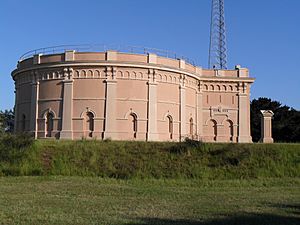Waverley Reservoirs facts for kids
Quick facts for kids Waverley Reservoirs |
|
|---|---|
| General information | |
| Completed | 1887,1917,1938 |
| Owner | MWS&DB |
| Dam and spillways | |
| Dam volume | 1,087,000 gallons 4,260,000 gallons 17,500,000 gallons 500,000 |

One of the four reservoirs, located adjacent to Paul Street, Waverley
|
|
| Location | Paul Street, Bondi Junction, Waverley Municipality, New South Wales, Australia |
| Built | 1887 |
| Architect | Public Works Department |
| Owner | Sydney Water |
| Official name: Waverley Reservoir No.1 (WS 0132); WS132; Waverley Reservoir (Elevated) (WS 0136); WS 0136 | |
| Type | State heritage (built) |
| Designated |
|
| Reference no. |
|
| Type | Water Supply Reservoirs / Dam |
| Category | Utilities - Water |
| Builders | Public Works Department |
| Lua error in Module:Location_map at line 420: attempt to index field 'wikibase' (a nil value). | |
The Waverley Reservoirs are a group of four large water tanks, called reservoirs. They are located on Paul Street in Bondi Junction, New South Wales, Australia. Two of these reservoirs are so important that they are listed on the heritage register.
These reservoirs were designed and built by the Public Works Department. Today, they are owned by Sydney Water, which is a government agency in New South Wales. The two special reservoirs were added to the New South Wales State Heritage Register in 1999 and 2002.
Contents
History of Waverley Reservoirs
How Waverley Got Its Name
The area called Waverley got its name from a book. This book was written by a famous Scottish author named Sir Walter Scott. An early settler named Barnett Levey built a house here in 1827. He called it Waverley House, after his favourite book.
Over time, this house became a well-known landmark. The area around it started to be called Waverley too. In 1859, Waverley officially became a municipality, which is like a local government area.
Why Waverley Needed Reservoirs
In the late 1800s, Sydney was growing fast. More people meant more demand for water. The existing water supply system, called the Botany Swamps Scheme, wasn't enough. People in higher areas like Waverley also needed water.
So, new reservoirs were needed to store and supply water to these growing suburbs. The Waverley Reservoirs were built to help with this big challenge.
Building the Waverley Reservoirs
The first reservoir, called Waverley Reservoir (covered), was finished in 1887. It was one of the last reservoirs built to help the Botany Swamps water system. Water was pumped to it from other reservoirs.
As Sydney kept growing, even more water was needed. This led to the building of two more reservoirs in 1917. These were Waverley Reservoir (elevated) and Waverley Reservoir No.1 (covered). The final reservoir, Waverley Reservoir No.3, was added in 1938.
The four Waverley Reservoirs show how much Sydney grew between 1887 and 1938. They also show how building techniques for reservoirs improved over time. They are a great example of how engineers solved the problem of getting water to everyone.
What the Reservoirs Look Like
Waverley Reservoir No.1
Waverley Reservoir No.1 is a large, round concrete tank. It's covered with soil and grass on top. This makes it look like a grassy hill. It has a concrete floor and walls.
On the grassy roof, there are cast iron caps for ventilation and access. These caps are lined up in a row. Because of their shape and arrangement, people sometimes call this reservoir Stonehenge. The top of the reservoir is often used as an open, grassy space.
The Elevated Reservoir
The Waverley Reservoir (elevated) is made of reinforced concrete. It has fancy and decorative sides. This reservoir is built right on top of Waverley Reservoir No.1. The columns that support the roof of the covered reservoir also support the elevated one.
This design was very clever and new for its time. The elevated reservoir also has a small, rectangular room attached to it. This room, called a valve house, has similar decorations on its walls. Above the entrance, you can see a shield with the words Sanitas est vita, which means "Health is life". Below that, it says when it was built: "ERECTED / BY THE / METROPOLITAN BOARD OF WATER SUPPLY / AND SEWERAGE SYDNEY / 1918 AD".
This elevated reservoir can hold about 2.3 million litres of water. In the 1960s and 1970s, a roof was added to it. This was done to keep the water clean and safe. Both reservoirs are still in use today and are in good condition.
Why They Are Heritage Listed
The group of four reservoirs at Waverley is very important. They show how different building methods were used for reservoirs over time. They also show how quickly Sydney's population grew and why water needed to be supplied to higher areas.
Importance of Waverley Reservoir No.1
Waverley Reservoir No.1 is special because it's one of the last reservoirs still working from the original Botany Swamps water system. It helps us understand how water supply grew as the population increased.
The fact that its roof is used as an open, recreational space is also a unique and important feature. This reservoir is one of only a few large covered reservoirs in the Sydney water system. Each one is different in how it was built and designed.
Importance of the Elevated Reservoir
The Waverley Reservoir (elevated) is one of the most decorated concrete reservoirs in Sydney. The way it was built on top of the covered reservoir shows how skilled the engineers were in the early 1900s.
This reservoir is also one of only a few elevated concrete reservoirs in the Sydney Water system. It's one of only two places where one reservoir is built right into another using such new technology.
Images for kids


